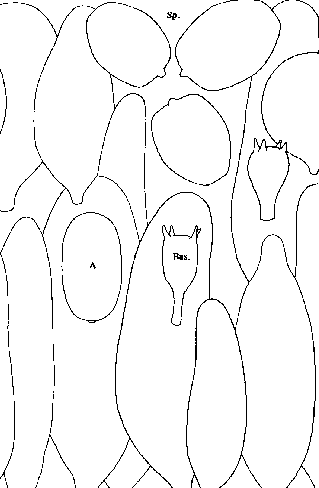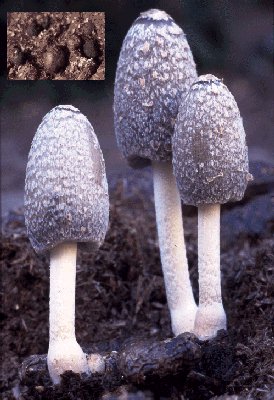Macroscopic features |
Pileus up to 18 mm high and 13 mm wide when still closed, first globose (primordia), soon ellipsoid, ovoid or conical, then campanulate, flattened when fully expanded and up to 25 mm wide. Veil a thick, felty layer, white, covering the whole pileus when young, splitting up in patches during expanding; pileus first white under veil, then pale to dark grey-brown (Mu. 10 YR 5/4, 4/4, 3/3, 3/1; K.& W. 5D4, 5E6, 5E5, 5F4), finally fuscous violaceous grey to black. Surface of pileus (below veil) often covered with a very thin gelatinous layer. Lamellae very crowded, up to 3.5 mm broad, white when very young, soon grey to dark grey with white edge, later black. Stipe up to 120 x 5-6 mm, white, somewhat fibrous, with yellow-brown drops when fresh, slightly widened downwards; after margin of pileus gets loose from bulbous base, a small, volva-like margin remains, with a finely striate imprint from the lamellae. Sclerotia subglobose, somewhat irregular, c. 10 mm in diam. or finger-shaped and then up to 35 x 10 mm, very dark brown. |
Microscopic features |
Spores [40,2,1] 13.3-17.5 x 10.3-12.3 x c. 9-10.5 µm, rounded angular ovoid in frontal view, ellipsoid to cylindrical ellipsoid in side view, lentiform, rather truncate, very dark red-brown, almost black, with central, hardly visible, c. 2.5 µm wide germ pore; Q = 1.25-1.45, av. Q = 1.35; av. L = 14.7-15.7, av. B = 11.1-11.3 µm. Basidia 22-40 x 12-17 µm, 4-spored, surrounded by 5-8(-9) pseudoparaphyses. Pleurocystidia 80-125(-160) x 25-45 µm, cylindrical, subutriform, oblong or ellipsoid. Cheilocystidia 60-100 x 30-40 µm, ellipsoid or ovoid, broadly ellipsoid, ellipsoid, oblong or utriform. Elements of veil diverticulate, thin-walled, 2-7 Ám wide. Between surface of pileus and veil a slimy layer is present, 70-100 µm thick and mixed with velar elements. Pileipellis made up of filamentous, in part inflated elements. Clamp-connections not found, only pseudoclamps (Uljé & Noordeloos 1993: 263). |
Habitat & distribution |
On sclerotia (see notes) in dung of cow (Limousines). Solitary. Very rare, only known from type-locality. |
Remarks |
The specimens studied did develop in culture on the collected sclerotia which were put in a transparent synthetic box, on wet moss. The sclerotia were collected in Apr. 1996, and basidiocarps developed on 6, 22, 24 and 26 May 1996. |

[Copyright © by ]

[Copyright © by Bart Horvers]